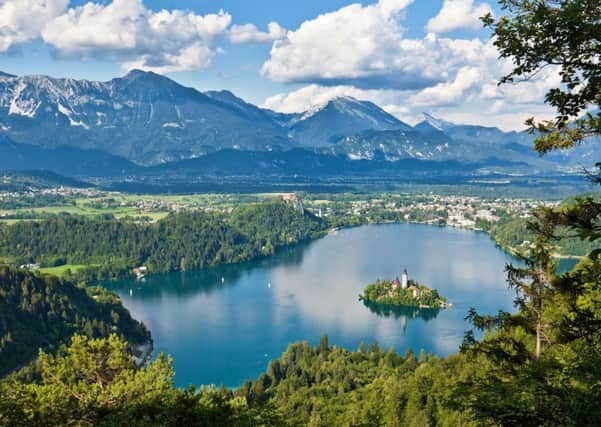Travel review: Why Slovenia is the next holiday honeypot


Balancing gingerly on a paddleboard, I’m torn between basking in the dry heat of Slovenia’s midday sun and abandoning everything to dive into the cool blue water.
I’m in – or rather, on – Lake Bohinj, a fine example of the natural beauty this Slavic country has to offer. The setting is beautiful – crystal-clear water below and rich green alpine trees in the distance, all enveloped by a section of the sprawling Julian Alps reaching high into the sky.
Advertisement
Hide AdAdvertisement
Hide AdSlovenia is an almost completely landlocked section of Eastern Europe which has slowly been gaining more attention from holidaymakers, but the prices and crowds are still modest.
This is particularly true for Lake Bohinj, where families have bedded in for the day to enjoy their own slice of paradise. Young lovers are paddling in the shallows, and a couple of older men are sitting watching ducks from the shade of a tree.
It’s possible to spin 360 degrees on my paddleboard and barely see a single trapping of the 21st century. Along with adrenaline-pulsing, calorie-burning activities, there are plenty of opportunities to indulge as well. Honey, for example, is one of the country’s biggest exports. Subtle reminders of how important it is are dotted across capital city, Ljubljana, just over an hour’s picturesque drive from Lake Bohinj.
“Honey is so central to being Slovenian,” says our guide Martin Sustersic during a tour of the medieval city. “A typical Slovenian breakfast is bread, butter and honey. We sweeten coffee with honey, and every important building in Ljubljana has a beehive at the top. There are hundreds of urban beehives in this city.”
Advertisement
Hide AdAdvertisement
Hide AdOne of those properties is Hotel Park, a contemporary city-centre hotel with a strong ecological focus. Its hives produce 60 to 80 kilos of the nectar every year, some used within the hotel and the rest sold to local businesses.
Honey is also used in one of the country’s cherished delicacies, potica, a sort of nut roll which features brown walnuts or green tarragon, and is best enjoyed at the top of a hill after a long slog.
Perhaps Slovenia’s best-known delicacy, though, is Bled cake – a three-layer slab of creamy goodness that owes its name to Slovenia’s popular holiday destination.
Aside from good cake, there are many more reasons to visit Lake Bled, the beauty spot in the far north-west of Slovenia, and one of the few places where it’s possible to find a crowd.
Advertisement
Hide AdAdvertisement
Hide AdFrom the beautifully quaint platna boats – the Slovenian equivalent of a gondola carrying passengers to tiny Bled Island – to the pure waters of Bled itself, it’s impossible to find a view unsuitable for the family photo album or Instagram. “Yes, the water is normally this colour,” says Croatian-born tour guide Dobrivoj Soboljev, also known as George.
Bled Island has its own traditions. Around 50 brides a year get married in its 60-seater Pilgrimage Church of the Assumption of Maria. It has a wishing bell which must be rung three times with the ringer’s back to the door, while grooms are required to carry their wives-to-be up the steps to the church.
As our own platna moors on the island, the scale of that task becomes apparent. “It’s 99 steps. Not easy,” George smiles, before adding that failure is not really an option.
Along with possibly the toughest pre-matrimonial challenge on the planet, Slovenia also lays claim to being one of the most environmentally-friendly destinations.
Advertisement
Hide AdAdvertisement
Hide AdCycling tours are a popular way of getting a feel for Ljubljana’s history in a short space of time, zipping around the significant cultural landmarks, such as the workplaces and homes of the three mustachioed men – Joze Plecnik, Ivan Cankar and Rihard Jakopic – credited with shaping the modern-day capital.
Within an hour, we have left the Hotel Kompas and are breathing in the beauty of the Planica alpine valley and its famous 400m ski slope.
In the summer, the ski slope doubles as the stage for the toughest 400m race in the world, the Red Bull 400, with athletes sprinting to the top in a madcap reverse of the famous Gloucester cheese rolling competition.
A more sedate attraction is the hidden gem that is the Zelenci Lake. The Green Lake, as it’s known, is a popular destination for those looking for peace and tranquillity. The glacial meltwater is at a near-constant 7C, with the white chalk base reflecting the sky above to create an unbelievable vivid green.
Advertisement
Hide AdAdvertisement
Hide AdAt Ljubljana’s Gostilna na Gradu restaurant, it is possible to enjoy the finest locally-produced fare in the grounds of the capital’s stunning castle.
Sampling the variety of fine, local dishes, I’m reminded of a comment made by one of our earlier guides, Martin. He playfully joked there was only one McDonald’s restaurant in the city.
That’s not strictly true, but he was right to point out that many of the global franchises that have infiltrated cities and diluted identity across the globe are yet to really permeate Slovenian society. For me, that’s the country’s real charm.
GETTING THERE
Inghams offers a 10-night, three-centre holiday, staying three nights on a bed and breakfast basis at the four-star Hotel Slon, in the Slovenian capital Ljubljana, followed by three nights on a half-board basis at the four-star Hotel Kompas, Kranjska Gora, followed by four nights on a half-board basis at the four-star Hotel Jezero, Lake Bohinj, from £1,341 per person, based on two sharing, including return flights from Gatwick to Ljubljana or Salzburg and all transfers.
To book, visit inghams.co.uk/lakes-mountains-holidays or call 01483 791 116.